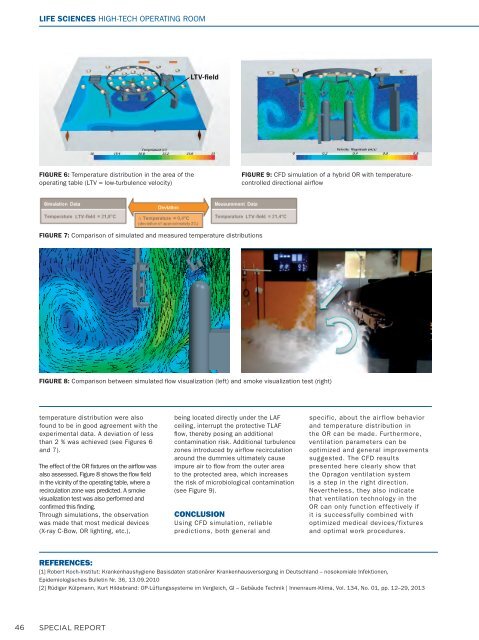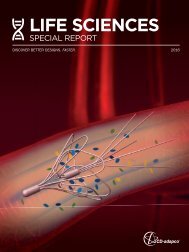Life science special report 161215 IY opt
Create successful ePaper yourself
Turn your PDF publications into a flip-book with our unique Google optimized e-Paper software.
LIFE SCIENCES HIGH-TECH OPERATING ROOM<br />
LT V - fi e l d<br />
FIGURE 6: Temperature distribution in the area of the<br />
operating table (LTV = low-turbulence velocity)<br />
FIGURE 9: CFD simulation of a hybrid OR with temperaturecontrolled<br />
directional airfl ow<br />
FIGURE 7: Comparison of simulated and measured temperature distributions<br />
FIGURE 8: Comparison between simulated fl ow visualization (left) and smoke visualization test (right)<br />
temperature distribution were also<br />
found to be in good agreement with the<br />
experimental data. A deviation of less<br />
than 2 % was achieved (see Figures 6<br />
and 7).<br />
The effect of the OR fixtures on the airflow was<br />
also assessed. Figure 8 shows the flow field<br />
in the vicinity of the operating table, where a<br />
recirculation zone was predicted. A smoke<br />
visualization test was also performed and<br />
confirmed this finding.<br />
Through simulations, the observation<br />
was made that most medical devices<br />
(X-ray C-Bow, OR lighting, etc.),<br />
being located directly under the LAF<br />
ceiling, interrupt the protective TLAF<br />
fl ow, thereby posing an additional<br />
contamination risk. Additional turbulence<br />
zones introduced by airfl ow recirculation<br />
around the dummies ultimately cause<br />
impure air to fl ow from the outer area<br />
to the protected area, which increases<br />
the risk of microbiological contamination<br />
(see Figure 9).<br />
CONCLUSION<br />
Using CFD simulation, reliable<br />
predictions, both general and<br />
specific, about the airflow behavior<br />
and temperature distribution in<br />
the OR can be made. Furthermore,<br />
ventilation parameters can be<br />
<strong>opt</strong>imized and general improvements<br />
suggested. The CFD results<br />
presented here clearly show that<br />
the Opragon ventilation system<br />
is a step in the right direction.<br />
Nevertheless, they also indicate<br />
that ventilation technology in the<br />
OR can only function effectively if<br />
it is successfully combined with<br />
<strong>opt</strong>imized medical devices/fixtures<br />
and <strong>opt</strong>imal work procedures.<br />
REFERENCES:<br />
[1] Robert Koch-Institut: Krankenhaushygiene Basisdaten stationärer Krankenhausversorgung in Deutschland – nosokomiale Infektionen,<br />
Epidemiologisches Bulletin Nr. 36, 13.09.2010<br />
[2] Rüdiger Külpmann, Kurt Hildebrand: OP-Lüftungssysteme im Vergleich, GI – Gebäude Technik | Innenraum-Klima, Vol. 134, No. 01, pp. 12–29, 2013<br />
46 SPECIAL REPORT



